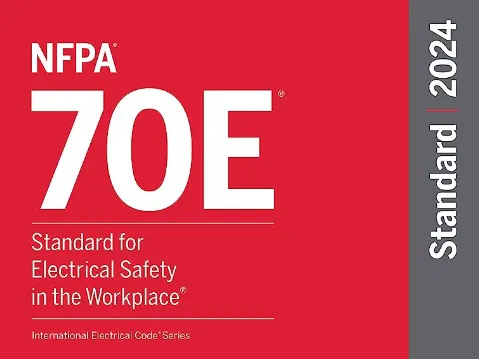Arc Flash Compliance and Training Solutions
Get a Free Estimate Today
** We do NOT send any marketing texts or emails.
EAP is Trusted by
ExxonMobile
Memorial Herman Hospitals
CBRE
JLL
And Many More
Get Compliant with an EAP Arc Flash Study
Ensure Reliability Safety with the Most Experienced in the Business
40+ Years of Experience
FREE Arc Flash PPE Labels
FREE NFPA 70E safety training
FREE System Hazard Detection
Guaranteed NEC Compliance
Proven Track Record of Safety
Trusted by:
ExxonMobile
Memorial Herman Hospitals
MD Anderson Hospitals
CBRE
JLL
And Many More
Get a Same-Day Free Estimate
** We do NOT send any marketing texts or emails.
Arc Flash Study Info
What is an Arc Flash Study?
An arc flash study, in simple terms, is like a safety assessment for electrical systems. Imagine your home's electrical panel but on a much larger scale, like in a high rise building, a hospital or an industrial facility. These studies evaluate the risks of sudden, intense electrical explosions called arc flashes that can happen when something goes wrong in these systems. Electrical Engineers analyze the setup, equipment, and procedures to figure out how to minimize the chances of these dangerous flashes occurring. This helps protect people working with or near electricity by recommending safety measures like wearing protective gear and following specific safety protocols to prevent injuries and damage.
What are Arc Flash Labels?
What Are Arc Flash Labels? These are warning labels that are required by OSHA to be placed on any equipment that requires maintenance while energized. This usually includes equipment like Switchboards, Panels, and Motor Control Centers. Equipment that has no safe method of cover removal like Transformers do not require labels. Also Equipment That is easily de-energized like Disconnects, Starters and VFDs do not require labels as they should not be worked on while energized
There are 2 types of arc flash labels, 𝗯𝗮𝘀𝗶𝗰 labels and 𝗰𝗼𝗺𝗽𝗿𝗲𝗵𝗲𝗻𝘀𝗶𝘃𝗲 labels. 𝗕𝗮𝘀𝗶𝗰 labels are only for 208 Volt panels. These labels have a warning information but no information about energy, PPE, or boundary information. For basic labels you should use the picture in this post and and the provided tables in NFPA 70E to determine proper PPE. 𝗖𝗼𝗺𝗽𝗿𝗲𝗵𝗲𝗻𝘀𝗶𝘃𝗲 labels are for 480 Volt panels. These labels have Shock Hazard Boundaries, Limited Approach, and Restricted Approach distances detailed on the bottom of the label. They also have Flash Hazard Boundary, Energy Levels, and PPE Requirements detailed.
NFPA 70E Requirements
According to the National Fire Protection Association (NFPA) Standard 70E, arc flash studies must be reviewed at least every five years.
This review should account for any changes to the electrical distribution system or to the IEEE 1584 standard.
An arc flash study should also be reviewed any time modifications are made to the facility that can affect the outcome of the study.
Major or minor variations such as fuse type or breaker setting adjustments can have a huge impact on personal safety.
Other times when an arc flash study is required include:
Major additions or modifications to your facilityEquipment is greater than 50 voltsYour state adopted the 2017 edition of NFPA 70You can't de-energize equipment remotely
OSHA requires employers to perform an arc flash hazard analysis and to implement appropriate protective measures, such as the use of personal protective equipment (PPE) and the proper maintenance of electrical equipment.
Arc Flash Study Requirements
Electrical System Diagrams: Gather detailed diagrams and drawings of your electrical system, showing the components, connections, and ratings. This is like having a map of your electrical setup.
Equipment Information: Collect data on all electrical equipment, including transformers, circuit breakers, switches, and panels. You need to know their specifications and conditions, like their age and maintenance history.
Fault Current Analysis: Calculate the maximum amount of electrical current that can flow during a fault (like a short circuit). This helps determine the potential danger of an arc flash.
Protective Devices: Identify and evaluate the protective devices in your system, such as fuses and circuit breakers. These are like safety switches that can prevent or mitigate arc flash incidents.
Clearing Time: Determine how long it takes for protective devices to respond and interrupt the fault current. This is crucial for assessing the duration of the arc flash event.
Working Distance: Define the distance between a worker and the electrical equipment during normal operation. This affects the level of protection needed for workers.
Equipment Labeling: Properly label equipment to indicate potential arc flash hazards. Workers need clear warnings about the dangers associated with specific equipment.
Hazard Categories: Classify the arc flash hazards into different categories based on the potential energy release. This helps workers choose appropriate personal protective equipment (PPE).
PPE Recommendations: Based on the hazard categories, recommend suitable personal protective equipment for workers, like arc-rated clothing and face shields.
Documentation: Keep records of the study, including data, calculations, and recommendations. Regularly review and update this information to ensure ongoing safety.
Arc Flash Study Cost
At EAP, we generally quote Around $120/node, but there is obviously a good amount of variance on that number depending the project.
The cost of an arc flash study can range from $3,000 to $100,000, depending on the size of the facility.
The larger the facility, the more expensive the study is likely to be.
Here are some cost ranges for arc flash studies:
Low end:$3,000Small to medium:$7,500 to $15,000High end:$75,000 to $100,00050 buildings:$625,000 to $960,000
Factors that can affect the cost of an arc flash study include:
The size of the facilityThe experience and qualifications of the electrical engineers
Arc flash studies usually take 4 to 6 weeks to complete.
The results of these studies can help employers:
Mitigate or reduce hazardsProvide labels to raise awarenessInform employeesSelect the proper PPE for the task

Arc Flash Study Requirements
Arc Flash Studies are Required:
Every 5 years.
After additions or modifications to electrical system.
If equipment is greater than 50 volts.
If you can’t de-energize equipment remotely.
Arc Flash Regulations:
Arc Flash Studies ensure your facility is compliant with NFPA, OSHA, NEC, and other state, local, and industry specific regulators.
NFPA: created standards that require arc flash studies at the request of OSHA.
NEC: code that requires labels and PPE be provided for employees.
OSHA: inspects workplaces for safe conditions (warning labels, PPE) and code adherence.
Deeper Dive:
NFPA 70E
The consensus standard for workplace electrical safety that establishes the method for complying with OSHA.
Arc Flash Assessment:Establish Shock protection and arc flash boundaries based on voltage and arcing energy.
One Line diagram: Post and maintain an updated one-line diagram
Labeling: 208V equipment can have basic label, and can use tables for arc flash, Need comprehensive labels for 480V equipment.
PPE: PPE type, arc rating and Glove class listed on the label, employers should provide hearing, eye and other required PPE
Training: Train employees every 3 years and after updates to code. Document training for each employee
Electrically safe work condition: Job descriptions, Work Procedures, Special Precautions, and Energy Source Controls, LOTO and Testing
Electrical maintenance program (EMP): Developed with NFPA 70B standards, Yearly infrared inspections
Emergency Response Plan: List steps to be taken in event of arc flash
National Electric Code (NEC)
Is also known as NFPA 70. Article 110.16 has the requirements for arc flash labeling. Here are some key points about arc flash labeling from the NEC:
Labeling Requirement: According to NEC article 110.16, electrical equipment that is likely to require examination, adjustment, servicing, or maintenance while energized must be marked with a label that warns of the potential arc flash hazard. This includes panelboards, switchboards, industrial control panels, etc.
Content of Labels: The arc flash labels should include a warning and provide the nominal system voltage, the available fault current, the arc flash boundary, and the personal protective equipment (PPE) requirements.
Method of Calculating Labels: The labels are typically generated based on engineering calculations, and they should be generated by a qualified person or organization like EAP.
Maintenance and Inspection of Labels: The labels must be maintained and inspected to ensure their accuracy at least every 5 years or when changes to the electrical system happen.
Energy reduction: New installations must have arc reduction technologies and be tested for performance. Arc reduction required for fuses and breakers >1200A. Clearing time <0.07 seconds required. Fuses need to be less than 1800A for 480V
Training: Workers should receive training on how to interpret and use the information provided on arc flash labels.
OSHA
Is the Enforcing agency for arc flash safety, and performs random inspections of workplaces to ensure compliance with arc flash safety standards. The primary standard related to arc flash safety is found in OSHA's general industry regulations, specifically under 29 CFR 1910.331 through 29 CFR 1910.335. OSHA will issues citations, fines, or other enforcement action if it finds arc flash safety standards are not being met.
Osha enforces all the guidelines mentioned in the NFPA and NEC, with focus workplace and employee safety. When inspecting workplaces OSHA checks for proper arc flash labeling on electrical equipment, training and safety programs for employees, and appropriate PPE provided to employees. Always make sure your company has these items readily available to keep your workplace safe and avoid enforcement by OSHA
Other
Joint Commission
The Joint Commission on Accreditation of Healthcare Organizations (JCAHO), sets the regulations for healthcare facilities, including hospitals. The Joint Commission doesn't directly enforce arc flash regulations like OSHA, but they do enforce safety standards, which includes arc flash hazards.
The Joint Commission has specific Environment of Care Standards that address safety hazards. These standards include electrical safety and equipment maintenance.Hospitals are required to perform regular risk assessments to identify potential safety hazards, such as electrical hazards and arc flashes. Hospitals are also required to comply with the NEC, which was discussed in detail earlier. The importance of safety training is emphasized in its accreditation standards. Hospitals are expected to provide staff with appropriate training on safety, including electrical safety. Finally, documentation of safety procedures, incident reports, and safety improvement initiatives addressing electrical safety issues is also required.
For hospitals and healthcare centers, it is important that electrical safety standards are being met for Joint Commission accreditation. Hope this helps you understand The Joint Commission's view on arc flash hazards.
I hope that you now have a better understanding of the regulations around Arc Flash and are better prepared to keep your workplace safe! If you Have any questions EAP is here to help with all your arc flash needs, reach out on our home page any time!

Arc Flash Study Requirements
Arc Flash Studies are Required:
Every 5 years.
After additions or modifications to electrical system.
If equipment is greater than 50 volts.
If you can’t de-energize equipment remotely.
Arc Flash Regulations:
Arc Flash Studies ensure your facility is compliant with NFPA, OSHA, NEC, and other state, local, and industry specific regulators.
NFPA: created standards that require arc flash studies at the request of OSHA.
NEC: code that requires labels and PPE be provided for employees.
OSHA: inspects workplaces for safe conditions (warning labels, PPE) and code adherence.
Deeper Dive:
NFPA 70E
The consensus standard for workplace electrical safety that establishes the method for complying with OSHA.
Arc Flash Assessment:Establish Shock protection and arc flash boundaries based on voltage and arcing energy.
One Line diagram: Post and maintain an updated one-line diagram
Labeling: 208V equipment can have basic label, and can use tables for arc flash, Need comprehensive labels for 480V equipment.
PPE: PPE type, arc rating and Glove class listed on the label, employers should provide hearing, eye and other required PPE
Training: Train employees every 3 years and after updates to code. Document training for each employee
Electrically safe work condition: Job descriptions, Work Procedures, Special Precautions, and Energy Source Controls, LOTO and Testing
Electrical maintenance program (EMP): Developed with NFPA 70B standards, Yearly infrared inspections
Emergency Response Plan: List steps to be taken in event of arc flash
National Electric Code (NEC)
Is also known as NFPA 70. Article 110.16 has the requirements for arc flash labeling. Here are some key points about arc flash labeling from the NEC:
Labeling Requirement: According to NEC article 110.16, electrical equipment that is likely to require examination, adjustment, servicing, or maintenance while energized must be marked with a label that warns of the potential arc flash hazard. This includes panelboards, switchboards, industrial control panels, etc.
Content of Labels: The arc flash labels should include a warning and provide the nominal system voltage, the available fault current, the arc flash boundary, and the personal protective equipment (PPE) requirements.
Method of Calculating Labels: The labels are typically generated based on engineering calculations, and they should be generated by a qualified person or organization like EAP.
Maintenance and Inspection of Labels: The labels must be maintained and inspected to ensure their accuracy at least every 5 years or when changes to the electrical system happen.
Energy reduction: New installations must have arc reduction technologies and be tested for performance. Arc reduction required for fuses and breakers >1200A. Clearing time <0.07 seconds required. Fuses need to be less than 1800A for 480V
Training: Workers should receive training on how to interpret and use the information provided on arc flash labels.
OSHA
Is the Enforcing agency for arc flash safety, and performs random inspections of workplaces to ensure compliance with arc flash safety standards. The primary standard related to arc flash safety is found in OSHA's general industry regulations, specifically under 29 CFR 1910.331 through 29 CFR 1910.335. OSHA will issues citations, fines, or other enforcement action if it finds arc flash safety standards are not being met.
Osha enforces all the guidelines mentioned in the NFPA and NEC, with focus workplace and employee safety. When inspecting workplaces OSHA checks for proper arc flash labeling on electrical equipment, training and safety programs for employees, and appropriate PPE provided to employees. Always make sure your company has these items readily available to keep your workplace safe and avoid enforcement by OSHA
Other
Joint Commission
The Joint Commission on Accreditation of Healthcare Organizations (JCAHO), sets the regulations for healthcare facilities, including hospitals. The Joint Commission doesn't directly enforce arc flash regulations like OSHA, but they do enforce safety standards, which includes arc flash hazards.
The Joint Commission has specific Environment of Care Standards that address safety hazards. These standards include electrical safety and equipment maintenance.Hospitals are required to perform regular risk assessments to identify potential safety hazards, such as electrical hazards and arc flashes. Hospitals are also required to comply with the NEC, which was discussed in detail earlier. The importance of safety training is emphasized in its accreditation standards. Hospitals are expected to provide staff with appropriate training on safety, including electrical safety. Finally, documentation of safety procedures, incident reports, and safety improvement initiatives addressing electrical safety issues is also required.
For hospitals and healthcare centers, it is important that electrical safety standards are being met for Joint Commission accreditation. Hope this helps you understand The Joint Commission's view on arc flash hazards.
I hope that you now have a better understanding of the regulations around Arc Flash and are better prepared to keep your workplace safe! If you Have any questions EAP is here to help with all your arc flash needs, reach out on our home page any time!
As Seen On








As Seen On








Here's What Others Are Saying

"TEXT FROM THE VIDEO."
"TEXT FROM THE VIDEO."
"TEXT FROM THE VIDEO."
"TEXT FROM THE VIDEO."
"TEXT FROM THE VIDEO."
"TEXT FROM THE VIDEO."


Gallery



Aging Roof? New Homeowner? Got Storm Damage?
You Can Trust Stellar Roofing to Get the Job Done Right
☑ Experienced & Proven Track Record
Our professional team has many years of combined experience in residential and commercial roofing system solutions.
☑ Most Competitive Rates
We make sure our prices are as competitive as possible in our market. Our goal is to make this project as cost-effective as possible without loss of quality. All costs are clarified up front.
☑ 5 Star Reviews
With hundreds of satisfied customers, Stellar Roofing has a plethora of verified consumers that will recommend our service.
☑ We Leave Job Sites Squeaky Clean
After we finish any residential job, we understand how important it is to clean up the job site so your business can go back to its normal routine.
☑ Extremely Thorough Estimates
During the estimate process, our trained roof specialists will note any issues with your roof, big or small, and explain how they can be resolved.
☑ Quality Products & Warranties
We use only the highest quality and top-rated materials. We provide a Lifetime Workmanship Warranty on all roofing and siding projects to coincide with the Manufacturer’s Material and Labor warranty.
We Work With Many Types of Roofs

Asphalt Shingle

Metal

Cedar

Slate
Get Your Free Estimate Today
Our team is here to help answer any questions you may have!
EAP
PO Box 33864, Reno NV 89533
Phone: (916) 414-9855
Copyright © 2023 EAP. All rights reserved.
